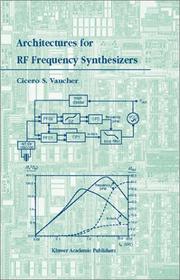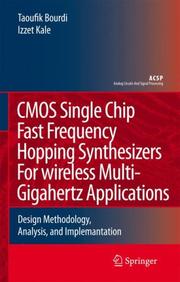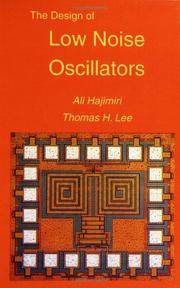| Listing 1 - 4 of 4 |
Sort by
|

ISBN: 0306479559 1402071205 9781402071201 Year: 2002 Publisher: Boston : Kluwer,
Abstract | Keywords | Export | Availability | Bookmark
 Loading...
Loading...Choose an application
- Reference Manager
- EndNote
- RefWorks (Direct export to RefWorks)
Frequency synthesizers are an essential building block of RF communication products. They can be found in traditional consumer products, in personal communication systems, and in optical communication equipment. Since frequency synthesizers are used in many different applications, different performance aspects may need to be considered in each case. The main body of the text describes a conceptual framework for analyzing the performance of PLL frequency synthesizers, and presents optimization procedures for the different performance aspects. The analysis of the PLL properties is performed with the use of the open-loop bandwidth and phase margin concepts, to enable the influence of higher-order poles to be taken into account from the beginning of the design process. The theoretical system analysis is complemented by descriptions of innovative system and building block architectures, by circuit implementations in bipolar and CMOS technologies, and by measurement results. Architectures for RF Frequency Synthesizers contains basic information for the beginner as well as in-depth knowledge for the experienced designer. It is widely illustrated with practical design examples used in industrial products.
Frequency synthesizers --- Radio frequency oscillators --- Phase-locked loops --- Integrated circuits --- Radio frequency integrated circuits --- Electrical & Computer Engineering --- Engineering & Applied Sciences --- Electrical Engineering --- Design and construction --- RFICs (Integrated circuits) --- Radio circuits --- Chips (Electronics) --- Circuits, Integrated --- Computer chips --- Microchips --- Electronic circuits --- Microelectronics --- Loops, Phase-locked --- Demodulation (Electronics) --- Oscillators, Electric --- Telecommunication --- RF oscillators --- Synthesizers, Frequency --- Frequency changers --- Oscillators, Crystal --- Signal generators --- Frequency synthesizers. --- Radio frequency oscillators. --- Phase-locked loops. --- Radio frequency integrated circuits. --- Design and construction.

ISBN: 1280957522 9786610957521 1402059280 1402059272 9048174783 Year: 2007 Publisher: Dordrecht : Springer,
Abstract | Keywords | Export | Availability | Bookmark
 Loading...
Loading...Choose an application
- Reference Manager
- EndNote
- RefWorks (Direct export to RefWorks)
Recently, wireless LAN standards have emerged in the market. Those standards operate in various frequency ranges. To reduce component count, it is of importance to design a multi-mode frequency synthesizer that serves all wireless LAN standards including 802.11a, 802.11b and 802.11g standards. With different specifications for those standards, designing integer-based phase-locked loop frequency synthesizers can not be achieved. Fractional-N frequency synthesizers offer the solution required for a common multi-mode local oscillator. Those fractional-N synthesizers are based on delta-sigma modulators which in combination with a divider yield the fractional division required for the desired frequency of interest. In CMOS Single Chip Fast Frequency Hopping Synthesizers for Wireless Multi-Gigahertz Applications, the authors outline detailed design methodology for fast frequency hopping synthesizers for RF and wireless communications applications. Great emphasis on fractional-N delta-sigma based phase locked loops from specifications, system analysis and architecture planning to circuit design and silicon implementation. The book describes an efficient design and characterization methodology that has been developed to study loop trade-offs in both open and close loop modelling techniques. This is based on a simulation platform that incorporates both behavioral models and measured/simulated sub-blocks of the chosen frequency synthesizer. The platform predicts accurately the phase noise, spurious and switching performance of the final design. Therefore excellent phase noise and spurious performance can be achieved while meeting all the specified requirements. The design methodology reduces the need for silicon re-spin enabling circuit designers to directly meet cost, performance and schedule milestones. The developed knowledge and techniques have been used in the successful design and implementation of two high speed multi-mode fractional-N frequency synthesizers for the IEEE 801.11a/b/g standards. Both synthesizer designs are described in details.
Frequency synthesizers. --- Wireless communication systems --- Radio frequency oscillators. --- Equipment and supplies. --- RF oscillators --- Oscillators, Electric --- Synthesizers, Frequency --- Frequency changers --- Oscillators, Crystal --- Signal generators --- Telecommunication. --- Microwaves. --- Systems engineering. --- Electronics. --- Communications Engineering, Networks. --- Microwaves, RF and Optical Engineering. --- Circuits and Systems. --- Electronics and Microelectronics, Instrumentation. --- Electrical engineering --- Physical sciences --- Engineering systems --- System engineering --- Engineering --- Industrial engineering --- System analysis --- Hertzian waves --- Electric waves --- Electromagnetic waves --- Geomagnetic micropulsations --- Radio waves --- Shortwave radio --- Electric communication --- Mass communication --- Telecom --- Telecommunication industry --- Telecommunications --- Communication --- Information theory --- Telecommuting --- Design and construction --- Electrical engineering. --- Optical engineering. --- Electronic circuits. --- Microelectronics. --- Microminiature electronic equipment --- Microminiaturization (Electronics) --- Electronics --- Microtechnology --- Semiconductors --- Miniature electronic equipment --- Electron-tube circuits --- Electric circuits --- Electron tubes --- Mechanical engineering --- Electric engineering
Book
ISBN: 9400701829 9400701837 Year: 2010 Publisher: Dordrecht : Springer,
Abstract | Keywords | Export | Availability | Bookmark
 Loading...
Loading...Choose an application
- Reference Manager
- EndNote
- RefWorks (Direct export to RefWorks)
Wireless sensor networks have the potential to become the third wireless revolution after wireless voice networks in the 80s and wireless data networks in the late 90s. Unfortunately, radio power consumption is still a major bottleneck to the wide adoption of this technology. Different directions have been explored to minimize the radio consumption, but the major drawback of the proposed solutions is a reduced wireless link robustness. The primary goal of Architectures and Synthesizers for Ultra-low Power Fast Frequency-Hopping WSN Radios is to discuss, in detail, existing and new architectural and circuit level solutions for ultra-low power, robust, uni-directional and bi-directional radio links. Architectures and Synthesizers for Ultra-low Power Fast Frequency-Hopping WSN Radios guides the reader through the many system, circuit and technology trade-offs he will be facing in the design of communication systems for wireless sensor networks. Finally, this book, through different examples realized in both advanced CMOS and bipolar technologies opens a new path in the radio design, showing how radio link robustness can be guaranteed by techniques that were previously exclusively used in radio systems for middle or high end applications like Bluetooth and military communications while still minimizing the overall system power consumption.
Low power radio. --- Sensor networks. --- Wireless communication systems. --- Wireless sensor networks. --- Electrical & Computer Engineering --- Engineering & Applied Sciences --- Electrical Engineering --- Frequency synthesizers. --- Radio frequency oscillators. --- Engineering. --- Solid state physics. --- Microwaves. --- Optical engineering. --- Electronic circuits. --- Circuits and Systems. --- Solid State Physics. --- Microwaves, RF and Optical Engineering. --- Electron-tube circuits --- Electric circuits --- Electron tubes --- Electronics --- Mechanical engineering --- Hertzian waves --- Electric waves --- Electromagnetic waves --- Geomagnetic micropulsations --- Radio waves --- Shortwave radio --- Physics --- Solids --- Construction --- Industrial arts --- Technology --- RF oscillators --- Oscillators, Electric --- Synthesizers, Frequency --- Frequency changers --- Oscillators, Crystal --- Signal generators --- Systems engineering. --- Engineering systems --- System engineering --- Engineering --- Industrial engineering --- System analysis --- Design and construction

ISBN: 0792384555 0306481995 9780792384557 Year: 2003 Publisher: New York : Kluwer Academic Publishers,
Abstract | Keywords | Export | Availability | Bookmark
 Loading...
Loading...Choose an application
- Reference Manager
- EndNote
- RefWorks (Direct export to RefWorks)
It is hardly a revelation to note that wireless and mobile communications have grown tremendously during the last few years. This growth has placed stringent requi- ments on channel spacing and, by implication, on the phase noise of oscillators. C- pounding the challenge has been a recent drive toward implementations of transceivers in CMOS, whose inferior 1/f noise performance has usually been thought to disqualify it from use in all but the lowest-performance oscillators. Low noise oscillators are also highly desired in the digital world, of course. The c- tinued drive toward higher clock frequencies translates into a demand for ev- decreasing jitter. Clearly, there is a need for a deep understanding of the fundamental mechanisms g- erning the process by which device, substrate, and supply noise turn into jitter and phase noise. Existing models generally offer only qualitative insights, however, and it has not always been clear why they are not quantitatively correct.
Oscillators, Electric --- Electronic circuits --- Electronic noise --- Radio frequency oscillators --- Oscillateurs --- Circuits électroniques --- Bruit électronique --- Oscillateurs haute fréquence --- Design and construction --- Noise --- Conception et construction --- Bruit --- -Electronic noise --- -Radio frequency oscillators --- RF oscillators --- Electric oscillators --- Electric apparatus and appliances --- Electric machinery --- Radio --- Noise, Electronic --- Signal theory (Telecommunication) --- Electric noise --- Electron-tube circuits --- Electric circuits --- Electron tubes --- Electronics --- Computer engineering. --- Design and construction. --- Electronic circuits. --- Electronic noise. --- Engineering. --- Noise. --- Oscillators, Electric. --- Oscillators. --- Electrical & Computer Engineering --- Engineering & Applied Sciences --- Electrical Engineering --- Radio frequency oscillators. --- Circuits électroniques --- Bruit électronique --- Oscillateurs haute fréquence --- EPUB-LIV-FT SPRINGER-B --- Electrical engineering. --- Circuits and Systems. --- Electrical Engineering. --- Systems engineering. --- Noisy circuits --- Electric engineering --- Engineering --- Oscillators, Electric - Design and construction --- Electronic circuits - Noise
| Listing 1 - 4 of 4 |
Sort by
|

 Search
Search Feedback
Feedback About UniCat
About UniCat  Help
Help News
News